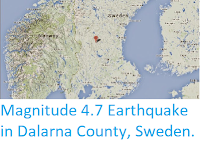A Norwegian man has died in an avalanche on Mount Kebnekaise, Sweden's highest mountain, on Tuesday 3 April 2018. The man, who has not been named but is described as having been in his sixties, was caught in the avalanche at about 2.00 pm local time, between Sielmatjåkka Peak and the Nallostugan Mountain Lodge, and pronounced dead in hospital later, despite being dug out promptly and given immediate first aid.
The approximate location of Mount Kebnekaise, Sweden's highest mountain. Google Maps.
Avalanches are caused by the mechanical failure of snowpacks;
essentially when the weight of the snow above a certain point exceeds
the carrying capacity of the snow at that point to support its weight.
This can happen for two reasons, because more snow falls upslope,
causing the weight to rise, or because snow begins to melt downslope,
causing the carrying capacity to fall. Avalanches may also be triggered
by other events, such as Earthquakes or rockfalls. Contrary to what is
often seen in films and on television, avalanches are not usually
triggered by loud noises. Because snow forms layers, with each layer
typically occurring due to a different snowfall, and having different
physical properties, multiple avalanches can occur at the same spot,
with the failure of a weaker layer losing to the loss of the snow above
it, but other layers below left in place - to potentially fail later.
Diagrammatic representation of an avalanche, showing how layering of snow contributes to these events. Expedition Earth.
See also...
Follow Sciency Thoughts on Facebook.








